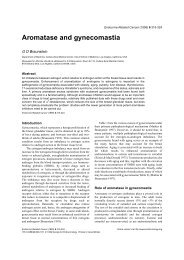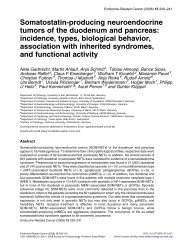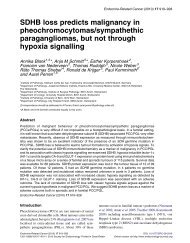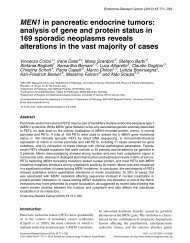Management of risk of breast carcinoma in postmenopausal women
Management of risk of breast carcinoma in postmenopausal women
Management of risk of breast carcinoma in postmenopausal women
Create successful ePaper yourself
Turn your PDF publications into a flip-book with our unique Google optimized e-Paper software.
Biglia et al.: Breast <strong>carc<strong>in</strong>oma</strong> <strong>in</strong> <strong>postmenopausal</strong> <strong>women</strong><br />
<strong>risk</strong> <strong>of</strong> <strong>breast</strong> cancer (RR=0.85-0.55) (Persson et al. 1994,<br />
Newcomb et al. 2001).<br />
Anthropometric variables<br />
The <strong>in</strong>fluence <strong>of</strong> some anthropometric variables, such as<br />
height and weight, on the <strong>risk</strong> <strong>of</strong> develop<strong>in</strong>g <strong>breast</strong> cancer<br />
is still the subject <strong>of</strong> debate. A weak correlation between<br />
height <strong>in</strong> adulthood and <strong>risk</strong> <strong>of</strong> <strong>breast</strong> <strong>carc<strong>in</strong>oma</strong> has been<br />
reported <strong>in</strong> many studies, with RR values for <strong>postmenopausal</strong><br />
<strong>women</strong> spann<strong>in</strong>g from 1.3 to 1.9 (Friedenreich<br />
2001). A recent analysis <strong>of</strong> seven prospective cohort<br />
studies reports a RR <strong>of</strong> 1.07 (CI = 1.03–1.12) for a 5 cm<br />
difference <strong>in</strong> height. Furthermore, <strong>women</strong> who reach their<br />
maximum height after 18 years have a lower <strong>risk</strong> <strong>of</strong><br />
develop<strong>in</strong>g <strong>breast</strong> cancer compared with those reach<strong>in</strong>g<br />
their maximum height before 13 years (OR = 0.7, 95%<br />
CI = 0.5–1.0) (van den Brandt et al. 2000). Height is<br />
correlated to genetic factors, diet, physical activity, age at<br />
menarche and exposure to endogenous estrogens; therefore,<br />
one could hypothesize that modify<strong>in</strong>g these factors<br />
at a young age could reduce the <strong>risk</strong> <strong>of</strong> <strong>breast</strong> cancer <strong>in</strong><br />
later years.<br />
Many studies have shown that body weight is directly<br />
correlated to <strong>breast</strong> cancer <strong>risk</strong> <strong>in</strong> <strong>postmenopausal</strong><br />
<strong>women</strong>; the RR varies, accord<strong>in</strong>g to the <strong>in</strong>dividual<br />
studies, from 1.0 to 1.9 and up to 2.2 for patients with a<br />
positive family history <strong>of</strong> <strong>breast</strong> cancer (Friedenreich<br />
2001). The association between body mass <strong>in</strong>dex (BMI)<br />
and cancer <strong>risk</strong> <strong>in</strong> <strong>postmenopausal</strong> <strong>women</strong> is not l<strong>in</strong>ear;<br />
the <strong>risk</strong> does not <strong>in</strong>crease further when BMI reaches 28<br />
kg/m 2 (RR = 1.26, 95% CI = 1.09–1.46) (van den Brandt<br />
et al. 2000). A slight weight ga<strong>in</strong> is associated with an RR<br />
<strong>of</strong> 1.2 <strong>in</strong> <strong>postmenopausal</strong> <strong>women</strong>, whereas the <strong>in</strong>crease is<br />
more pronounced for those who ga<strong>in</strong> more weight<br />
(RR = 2.3) (Friedenreich 2001). Data retrieved from the<br />
Nurses’ Health Study confirm a significant association<br />
between high BMI and low <strong>breast</strong> cancer <strong>in</strong>cidence before<br />
the menopause, and much weaker association after the<br />
menopause. However, a positive relationship between<br />
BMI and <strong>breast</strong> cancer <strong>risk</strong> was also seen among<br />
<strong>postmenopausal</strong> <strong>women</strong> provided they never used HRT<br />
(RR = 1.59 for BMI>31 kg/m 2 vs BMI 20 kg/m 2 ; 95%<br />
CI = 1.09–2.32; P < 0:001). In particular, a high BMI at<br />
the age <strong>of</strong> 18 years was found to be associated with a<br />
lower <strong>breast</strong> cancer <strong>in</strong>cidence both before and after the<br />
menopause. Weight ga<strong>in</strong> after the age <strong>of</strong> 18 years was<br />
unrelated to <strong>breast</strong> cancer <strong>in</strong>cidence before the menopause,<br />
but was positively associated with <strong>breast</strong> cancer<br />
<strong>in</strong>cidence after the menopause. This positive relationship<br />
between <strong>risk</strong> and weight ga<strong>in</strong> was limited to <strong>women</strong> who<br />
never used <strong>postmenopausal</strong> hormones; among these<br />
<strong>women</strong>, the RR was 1.99 (95% CI = 1.43–2.76) for a<br />
weight ga<strong>in</strong> <strong>of</strong> more than 20 kg vs unchanged weight<br />
ðP < 0:001Þ (Huang et al. 1997).<br />
Weight loss after the age <strong>of</strong> 45 only reduces the <strong>breast</strong><br />
cancer <strong>risk</strong> <strong>in</strong> postmenopause <strong>in</strong> <strong>women</strong> who had reached<br />
their maximum weight before 45 years <strong>of</strong> age (OR = 0.90,<br />
CI = 0.84–0.98 for 5 kg weight loss). In contrast, for<br />
<strong>women</strong> who reach their maximum weight after 45 years <strong>of</strong><br />
age, a decrease <strong>in</strong> weight does not modify their <strong>risk</strong><br />
(OR = 1.00, CI = 0.95–1.05 for 5 kg weight loss). F<strong>in</strong>ally,<br />
cyclic variations do not seem to modify the <strong>risk</strong> <strong>of</strong> <strong>breast</strong><br />
cancer <strong>in</strong> <strong>postmenopausal</strong> <strong>women</strong> (Trentham-Dietz et al.<br />
2000).<br />
Lifestyle<br />
Dietary fat <strong>in</strong>take<br />
The association between dietary fat <strong>in</strong>take and <strong>breast</strong><br />
cancer <strong>risk</strong> is highly debated. Although a reduction <strong>of</strong><br />
circulat<strong>in</strong>g estradiol, both <strong>in</strong> pre- and <strong>postmenopausal</strong><br />
<strong>women</strong>, has been observed after the reduction <strong>of</strong> fat <strong>in</strong> the<br />
diet (Wu et al. 1999), more recent epidemiological studies<br />
have not shown a correlation between fat <strong>in</strong>take and the<br />
<strong>risk</strong> <strong>of</strong> <strong>breast</strong> cancer (Lee & L<strong>in</strong> 2000, Smith-Warner et al.<br />
2001, Byrne et al. 2002, Horn–Ross et al. 2002).<br />
Consider<strong>in</strong>g the difficulty both <strong>in</strong> quantify<strong>in</strong>g and<br />
qualify<strong>in</strong>g fat <strong>in</strong>take and <strong>in</strong> compar<strong>in</strong>g results <strong>of</strong><br />
observational studies, the Women’s Health Initiative <strong>in</strong><br />
the USA has launched a randomized cl<strong>in</strong>ical trial that will<br />
allow calculation <strong>of</strong> the real value <strong>of</strong> this <strong>risk</strong> factor (The<br />
Women’s Health Initiative Study Group 1998).<br />
Alcohol consumption<br />
Most epidemiological studies have highlighted a positive<br />
association between alcohol <strong>in</strong>take and the <strong>risk</strong> <strong>of</strong><br />
develop<strong>in</strong>g <strong>breast</strong> <strong>carc<strong>in</strong>oma</strong> <strong>in</strong> both pre- and <strong>postmenopausal</strong><br />
<strong>women</strong>, with a RR vary<strong>in</strong>g from 1.1 to 4.0<br />
(S<strong>in</strong>gletary & Gapstur 2001). The <strong>risk</strong> is dose-dependent<br />
as demonstrated by the experimental observation that<br />
start<strong>in</strong>g from an <strong>in</strong>take <strong>of</strong> 60 mg/day, there is a 9% <strong>risk</strong><br />
<strong>in</strong>crease for every 10 g <strong>in</strong>crease <strong>in</strong> daily alcohol consumption<br />
(Smith-Warner et al. 1998). It has also been estimated<br />
that about 2% <strong>of</strong> <strong>breast</strong> cancers <strong>in</strong> the USA can be<br />
attributed to alcohol consumption (Tseng et al. 1999); <strong>in</strong><br />
Italy this figure rises to 15% (Mezzetti et al. 1998).<br />
In <strong>postmenopausal</strong> <strong>women</strong> who are not us<strong>in</strong>g HRT,<br />
serum levels <strong>of</strong> estradiol and androgens are only slightly<br />
<strong>in</strong>creased by a moderate alcohol <strong>in</strong>take. In <strong>women</strong><br />
dr<strong>in</strong>kers who take HRT, estradiol concentration is even<br />
more <strong>in</strong>creased by alcohol, s<strong>in</strong>ce it is around 3.3 times<br />
higher than that <strong>in</strong> non-dr<strong>in</strong>kers (G<strong>in</strong>sburg 1999).<br />
72 www.endocr<strong>in</strong>ology.org






